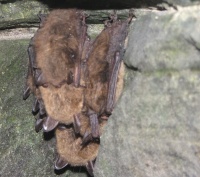White-Nose Syndrome (WNS)

Little Brown Bats in a rock crevice outside Aeolus Cave, near Dorset, Vermont.
Bat White-Nose Syndrome: An Emerging Fungal Pathogen?
Science Magazine Publication - A previously undescribed, cold-loving fungus has been linked to white-nose syndrome, a condition associated with the deaths of over 100,000 hibernating bats in the northeastern United States. The findings are published in this week’s issue of Science.
Download PDF
The condition in bats known as 'white-nose syndrome' (WNS) was first noted among dead and hibernating bats found in caves near Albany, New York, by the New York State Department of Environmental Conservation beginning in February 2007. Affected bats appeared to have a white substance on their heads and wings. In early 2008, “white-nosed” bats were once again seen in hibernaculae. Since March 2008, biologists and cavers have documented thousands of dead and dying bats at over 25 caves and mines in New York, Vermont, Massachusetts and Connecticut.
A Wildlife Disease Specialist from the USGS National Wildlife Health Center (NWHC) met with biologists in some affected areas in March 2008 and collected environmental samples from affected caves and mines in Vermont, New York and Massachusetts. Live, dead and dying bats were documented in and outside of their hibernacula.
Since February 2008, the NWHC has received nearly 100 bat carcasses, both euthanized and recently dead. Species include little brown, big brown, northern long-eared and eastern pipistrelle bats, and most of these bats have been from New York, Vermont, Massachusetts, and Connecticut.
The most common findings in the bats have been emaciation and poor body condition. Many of the bats examined had little or no body fat. A subset of the bats examined also exhibited changes in the lung that have been difficult to characterize. A majority of bats had microscopic fungal hyphae on the external surfaces of their bodies. The white substance observed on some bats may represent an overgrowth of normal fungal colonizers of bat skin during hibernation and could be an indicator of overall poor health, rather than a primary pathogen. Investigations into the cause of the morbidity, including underlying environmental factors, potential secondary microbial pathogens and/or toxicants, are underway.
Report WNS observations to your state conservation agency, the U.S. Fish and Wildlife Service or the USGS National Wildlife Health Center.
To report wildlife mortality events to USGS, please visit the mortality reporting page or contact a member of NWHC’s Field Investigations Team:
April 30, 2008 Wildlife Health Bulletin on White-nose Syndrome:White-Nose Syndrome in Bats in the Northeastern U.S.
Contributors: Cornell University, New York State Department of Environmental Conservation, New York State Department of Health, US Fish and Wildlife Service, and Disney's Animal Kingdom.
|